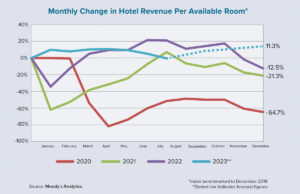There are about 7,000 languages spoken in the world today — 7,001 if you count the language of real estate finance. Over the years, the industry has developed its own unique vocabulary that consists of thousands of terms.
One commonly used reference book starts with the term “AAA Tenant” and ends 437 pages later with “Zoning Estoppel.” Although it is impossible to memorize all of these definitions, it is incumbent on the commercial mortgage broker to learn the essential phrases of this unique language.
One reason you need to master commonly used terms is that, inevitably, one of your investor clients will have a question about a document and you won’t inspire confidence if you are tripped up by basic vocabulary. So, let’s start with the theory underpinning two of the most common terms: mortgages and deeds of trust.
One reason you need to master commonly used terms is that, inevitably, one of your investor clients will have a question about a document and you won’t inspire confidence if you are tripped up by basic vocabulary.
Debt theory
Although mortgages and deeds of trust are similar in that the title to real estate is offered as collateral for a loan, these legal instruments have major differences for the parties involved, and their respective obligations and duties.
State law will determine the type of security instrument used to fund the commercial real estate transaction. Each state follows one of two theories, known as lien theory and title theory. Each theory determines how ownership is held and how foreclosure proceedings are executed when a loan defaults.
Under lien theory, the property deed is conveyed to the borrower. The lender files a lien (a mortgage) against the property to perfect their security interest in the collateral. The filing puts the world on notice that the property is subject to a senior mortgage. Once the loan is satisfied, the lender removes the lien.
In title theory states, the borrower does not retain title to the subject property during the life of the loan. The seller delivers to the buyer (borrower) a deed to the property. Once the borrower signs the security instrument (deed of trust), the title is conveyed back to the lender. The lender holds title to the property as security only during the loan term. The borrower has the right to possess the property and the lender delivers the deed to the borrower when the loan obligation has been fully satisfied.
The basics
A mortgage is defined as a debt instrument used to buy a property or to borrow money against a property owned by the borrower. The mortgage gives the lender the right to take the subject property if the borrower defaults on the loan.
Importantly, foreclosing on a mortgage is typically a judicial proceeding that requires the lender to file a lawsuit with a court and prove that they have completed the necessary actions to remedy the default status. This process is expensive and time-consuming, and can take 12 months or more to complete. In other states, foreclosures commonly involve nonjudicial proceedings that can move more quickly.
Like a mortgage, a deed of trust pledges real property to ensure the repayment of a loan. The deed holder is known as the trustee and is an independent third party that holds legal title to the subject property on the lender’s behalf. The primary role of the trustee, which is usually a title company, escrow company or bank, is to sell the property at a public auction if the borrower (or trustor) defaults on the loan. The lender is known as the beneficiary.
From the lender’s perspective, the deed of trust has a clear advantage over a mortgage. If the borrower defaults on the loan, the trustee has the power to foreclose on the property on behalf of the lender and bypass the court system entirely while obeying the procedures outlined by the deed of trust and state law. This process may take three to four months to complete.
Meanwhile, a promissory note is a written, unconditional promise to pay a certain sum of money. It is another legal instrument required in the real estate financing process. A promissory note is a financial instrument that contains a written promise by one party (the maker) to pay another party (the payee) a specific sum of money. The promissory note contains all terms relating to the debt, such as the principal amount owed, interest rate, regular payment amount and maturity date, and it requires the trustor’s signature. The promissory note is the evidence of indebtedness.
Ultimately, the commercial mortgage broker has an obligation to make clear to the borrower the entirety of the proposed agreement.
Other terms
Although there are hundreds or thousands of additional terms that you will run across in the course of your career, here are some essential ones to know. They tend to crop up a lot in documents and your borrower may not be familiar with them.
Acceleration clauses allow the lender to promptly call the loan due and payable in full if default occurs. In other words, the borrower has to immediately pay the entire outstanding balance.
- Alienation clauses allow the lender to call the loan due and payable if the property is sold. It prevents the borrower from transferring the loan obligation to a new owner. It also is known as a due-on-sale or nonassumption clause.
- Debt service refers to the loan payments of principal and interest only. It does not include taxes and insurance.
- Default is the failure to repay the principal and interest on a loan. Default also occurs when the borrower fails to pay property taxes or keep the property adequately insured.
- Escalation clauses are written into a loan agreement to allow for payments to be increased at a specified time by a specified amount. This term is more frequently found in lease and purchase contracts.
- Nondisturbance clauses protect the rights of tenants if the owner defaults and the lender forecloses on the property.
- Nonrecourse loans are mortgages secured by a pledge of real property, but the borrower is not made personally liable in case of default. A nonrecourse loan also will usually include so-called bad boy carveouts. These are exceptions that result in full-recourse liability for the borrower if certain promises are broken, such as if the borrower commits fraud or other acts of malfeasance.
- Recourse loans allow the lender to go after other borrower assets that were not used as loan collateral, or to take legal action in case of default in order to pay off the full debt.
Whether dealing with a mortgage, deed of trust, promissory note or any other financing documents, the objective is to establish mutual assent, meaning two parties found common agreement and are prepared to enter into a binding contract. The contract contains numerous provisions designed to establish full and complete understanding of the duties and obligations of all parties. This means all parties must have a thorough understanding of the terms contained within the agreement.
● ● ●
Ultimately, the commercial mortgage broker has an obligation to make clear to the borrower the entirety of the proposed agreement. All brokers should try to become as fluent as they can in the language of real estate finance. ●
Author
-
Garry Barnes is managing director of PW Partners Consultancy, headquartered in Salt Lake City, and is a freelance writer. He is a former president and CEO of banks in Arizona, California and Utah. He has taught at the university level, and is a frequent writer and lecturer on banking, finance and real estate matters. Barnes has served on the U.S. Small Business Administration’s National Advisory Council and received the SBA Arizona Financial Services Advocate of the Year award.




